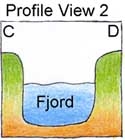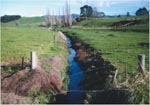PDF of this article (151 KB)

Stephanie Parkyn Aslan Wright-Stow John Quinn
Streambank plantings might be good for the stream ecosystem, but do people like the look of the results?
An important benefit of riparian buffer zones can be their aesthetic appeal. Barriers to implementing riparian management could be related to opinions that are based on practical or aesthetic reasons.
Which of these four streams do you like the best?



Stream D.
We asked 1050 people at the Waikato Agricultural Fieldays in July 2002 to rank each of the photos on the left from “most liked” to “least liked”, and to comment on reasons for their choice. Our aim was to see if people liked or disliked the look of riparian management (in the form of fenced and planted stream banks) and to find out some reasons why.
We chose two large and two small streams, with and without riparian management, and matched the photos as closely as possible in terms of aspect, weather, stream type, and so on. We avoided using streams that showed obvious bank erosion and poor water quality (such as high turbidity), so that the comparisons were fair.
Who answered the survey?
Most respondents were from North Island, with about 40% from Waikato and less than 5% from the South Island. About 60% were male and 40% female. The best-represented age group was 45–60 (34% of respondents), followed by 30–44 (27%).
Was there a difference between farmers and non-farmers?
Surprisingly – no. About one-third of our respondents were not farmers, but their pattern of preferences was almost exactly the same as that of farmers. However, all responses were gathered at the Fieldays, so it is likely that even the non-farmers in our sample were interested in farming to some degree.
So which stream was most preferred?
Photo A was the clear winner, followed by B, which was equally chosen as first, second and third choices. D and C were least liked, particularly C with about 900 people (83%) ranking it as third or fourth.
Overwhelmingly, people liked the streams to look clean, healthy and natural. About 25% of respondents regarded streams A and B as clean and natural, despite the fact that stream B had no native vegetation. What factors make a stream look clean and natural? Perhaps this is related to stream size, channel meandering, and tidy (weed-free) banks. Our least-liked stream (C) was small and identified as channelised and untidy.
Many people tended to view the stream in connection with the riparian zone, so features such as the vegetation were important to the decision of which stream looked best. Others judged the streams on water aspects such as colour, shape, size, flow, and depth. Bigger was better! In general, people preferred the bigger streams (A, B), but there is probably an upper limit on how big is big enough, as people also said “not too wide”.
Comments showed that our respondents had widely varying views on the same streams. For instance, some regarded photo B as “appealing”, “easy on the eye” with “well kept banks” and “good grazing”. Others saw it as “boring”, “not enough trees”, “sterile” with “bare banks”. The willows in photo B concerned some people, who considered them to be a risk of blocking the stream.
Riparian management or not?
Most encouragingly, there was a high degree of knowledge about fencing and riparian vegetation evident from the responses, with many people recognising that stock access to streams was bad. On the other hand, practical aspects were still important to some with comments suggesting that access for stock watering or crossing and water for irrigation were important.
A high proportion of people ranked the streams with riparian management as both their first and second choices (33%) compared to only 6% who ranked both of the streams without riparian management highest. However, not all riparian vegetation was equal. The riparian buffer in photo A was preferred to that of photo D largely because D appeared to some people as untidy and overgrown. This suggests that we need to manage expectations about the look of riparian zones while they are developing, and that we need to do more educating about the value of long grasses: they have a filtering function so they aren’t as bad as they look!
There were also concerns about weed problems, particularly that weeds could spread into surrounding pasture from the buffer zone.
Conclusions and implications
- Clean, healthy and natural looking is important.
- People do like the look of vegetated riparian zones.
- Size matters.
- There is a high degree of knowledge about the benefits of fencing and revegetating buffer zones.
- Long grasses look untidy to some!
- Weed management is important.
So, if you are a farmer interested in planting along stream banks to improve stream health or to increase the value of your property – take heart! People do appreciate your efforts!
Teachers: this article can be used for NCEA Achievement Standards in Agricultural/Horticultural Science (1.5, 1.7, 2.3), Biology (1.5, 2.2, 2.5, 3.2). See other curriculum connections at www.niwa.co.nz/pubs/wa/resources
Stephanie Parkyn, Aslan Wright-Stow and John Quinn are based at NIWA in Hamilton.
Acknowledgements
Wendy Boyce and Jill Thomson from Environment Waikato helped to design and interpret this survey.
